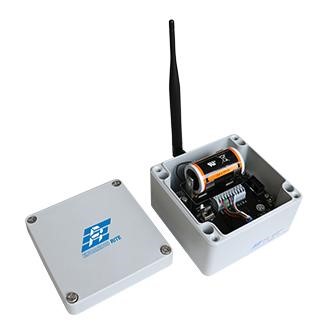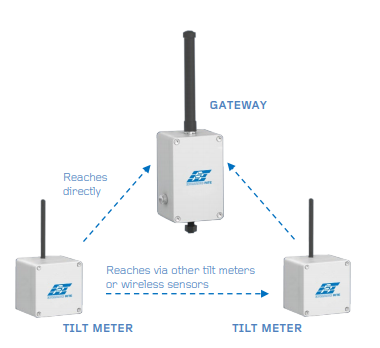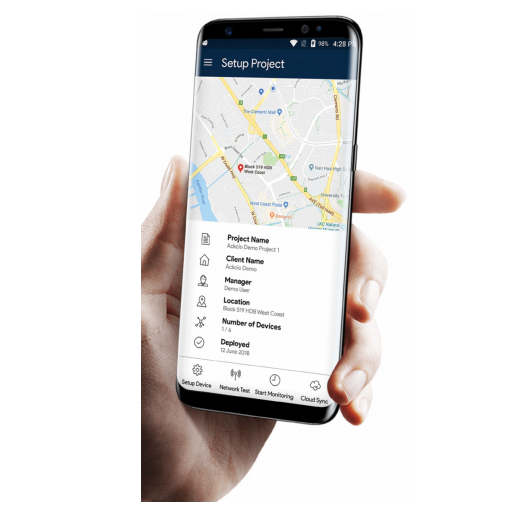A tilt meter is a geotechnical instrument widely used to monitor the vertical rotation, deflection, and deformation of the diaphragm and retaining walls. It is very sensitive and can pick up even the minute changes that occur, whether it is on the ground or a structure.

Encardio Rite Wireless Tilt meter is designed for remote monitoring of minute changes in inclination as well as vertical rotation of any structure. Equipped with a high-precision MEMS Sensor and a radio transmission network, the geotechnical instrument can provide accurate and reliable data. With the help of the Wireless Mesh Network, it can swiftly transfer data over long distances without any delay, and hence, keeps the authorities up-to-date on the slightest change taking place in the project.
With real-time data and correct analyses, the concerned party is able to make crucial decisions on time, amplify security, and reduce delays. It also proved to be a more cost-effective solution!
Let’s have a quick look at its features and application, before moving on to its working in detail.
Features of the Wireless Tilt Meter
- The equipment is quite easy to install and can be used efficiently in remote and hard-to-access sites and tunnels.
- The geotechnical instrument makes use of a wireless mesh-based data collection protocol that provides seamless connectivity in remote and large sites and tunnels.
- Allows the data to travel wireless over long distances without any delay or change.
- It is a standalone unit enclosed in a weatherproof compact.
- It provides reliable and high-resolution readings with long-term stability.
- Equipped with a robust battery that works uninterrupted for over 8 years.
Application of Wireless Tilt Meter
The Encardio Rite tilt meter finds its application in a wide number of fields. Let’s take a look.
- Underground space like tunnels and metro stations – monitoring inclination and rotation.
- Landslide-prone areas- Monitoring the stability of structures, surrounding areas, etc.
- Retaining walls and building – Remote Tilt Monitoring.
- Embankments, retaining walls, etc – Monitor deformation.
- Assess the performance of bridges and struts under load.
There are many reasons for a tilt change, which can then be fatal and a risk to everyone. Tilt changes in structures can be because of the construction activities such as heavy excavation; tunneling and dewatering. All these activities affect the ground that supports the structure and its foundation. Similarly, changes in tilt may also be attributed to the loading of a structure. For example, loading of a dam during impoundment, loading of a diaphragm wall during excavation, or loading of a bridge deck due to wind and traffic.
The wireless tilt meter provides accurate data that helps to identify the early signs of threats or warnings. This, in turn, gives enough time to take corrective measures and safe evacuation of the area.
Read more: What Are Tiltmeters And Where Are They Used?
Specification
| Sensor | Biaxial |
| Measuring Range | ± 15° |
| Output (Nominal) | 4 V at 15°proportional to sine of angle (EAN-91M) |
| Sensitivity | ± 10 arc seconds |
| Accuracy | ± 0.1 % fs |
| Transmission Distance | Up to 15 km (line of sight) Up to 4 km (cities, urban) Up to 3 km (tunnels, underground) |
| Power Supply | 12 V DC @ 2A nominal, Solar panel |
| Battery | 1 D-cell Lithium Thionyl Chloride (Li-SOCl2) 3.6 V 19 Ah batteries. |
Operating Principle
Wireless tilt meter – A brief explanation of how it works
Encardio Rite Model EAN-95MW is a wireless tilt meter that embodies a MEMS sensor with 4 V nominal output at ± 15°. This allows the output to be transmitted through a mesh wireless network uninterrupted over a long distance with no signal degradation. The geotechnical instrument is individually calibrated to present with a high system accuracy and repeatability.
The tilt meters are placed on a vertical or horizontal surface either directly with the help of 4 mounting screws or fasteners or using a mounting kit that helps to provide flexibility to mount the tilt meter. When the movement of the structure causes a shift in the tilt, this is reflected as a change in the output of the sensor.
The tilt can be measured on horizontal as well as vertical surfaces. The subsequent set of readings will indicate the behaviour of the structure and the permanent deformation over time.
Mounting Variants
The Model Model EAN-95MW tilt meter is provided with standard mounting screws/fasteners bracket suitable for wall mounting/vertical surface. In some unique cases, you can request to mount the tilt meter on a roof/suspended from the ceiling or on the floor.

Wireless Mesh Network
The Encardio Rite Wireless tilt meter is interfaced with a long-range, low-power wireless mesh network that enables the tilt meter to transmit the recorded data to the Gateway. This transferred data is over 99% reliable. Once the data reaches the Gateway, it then uploads it onto the central/cloud server making it easily available.
The innovative technology of using a wireless mesh-based data collection network enables us to enjoy seamless and uninterrupted connectivity in large tunnels and sites. Since the system is low-powered and consists of long-range wireless radios, it is able to provide a range of up to 15 km in each hop of the mesh network.
Cloud-hosted data management and configuration software can be used to manage the network. The configuration is performed with the help of a smartphone application that comes with the entire system, free of cost.

The application is designed to provide step-by-step instructions and all the crucial information. It also displays the radio signal and battery strength, and whether or not they are strong enough to carry out the task.
The database management system permits the display of analysis and visualization of the collected sensor data. This data is then made accessible to all the concerned authorities 24*7. The system is devised to generate automatic reports and send automatic alerts over SMS or email whenever any reading crosses the alert and safety levels.
The mesh network works seamlessly without any delay even when there are multiple tilt meters used at a site. Even if a particular tilt meter cannot reach the gateway, it can still send its data to another tilt meter in the network, which will then be passed on to the gateway. The mesh network allows the tilt meter to communicate with one another, therefore, enabling them to relay other tilt meter data to the gateway.
The system is known to get rid of the usual wireless problems like signal blockages and interference. This, in turn, gives you a smooth and reliable pathway to send the data to the gateway. Every single radio transmission in the system is secured using AES-128 encryption to maximize the security of the sensor data gathered by the system.